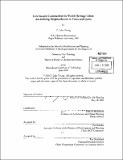Low-income communities in World Heritage Cities : revitalizing neighborhoods in Tunis and Quito
Author(s)
Young, T. Luke, 1972-
DownloadFull printable version (8.724Mb)
Other Contributors
Massachusetts Institute of Technology. Dept. of Architecture.
Advisor
John de Monchaux.
Terms of use
Metadata
Show full item recordAbstract
Since the 1970s, international preservation and funding agencies have promoted revitalization projects in developing countries aiming to, among other things, benefit low-income communities. For the most part, these projects have resulted in visibly improved physical spaces, reflecting upgraded infrastructure along with conservation of the architectural fabric. These outcomes are impressive in light of decades of neglect and decay. The impact on low-income residents, however, remains obscure. In what cases have the poor really benefited from these revitalization projects? Through what specific channels can low-income communities benefit from interventions? How have governments in these countries responded to the external pressure to benefit low-income residents given their often limited institutions and budgets? This thesis seeks address these questions. In particular, it aims to understand the conditions under which revitalization projects in historic cities of developing countries can benefit low-income communities. It begins by considering the evolution of international philosophy, following the shift from a central focus on monument preservation to that of urban revitalization, with a notable difference being the incorporation of social objectives in the latter phase. It then turns to exploring how these goals of revitalization have played out in two World Heritage Cities, Tunis and Quito. Findings indicate that low-income residents have indeed benefited from revitalization projects in both cases. Drawing from these experiences, this thesis reveals four common elements in the process through which this favorable outcome was achieved: 1) a significant component of public participation, 2) a semi-public development agency with operational flexibility and innovative financing strategies, 3) international catalysts in the form of World Heritage recognition and collaboration with international organizations and agencies, and 4) image improvement leading to a renewed self-image of the neighborhood. While these four elements by no means offer a template for success, they do indicate institutional structures that may support developing countries' efforts to reach the poor while revitalizing their cities.
Description
Thesis (S.M.)--Massachusetts Institute of Technology, Dept. of Architecture, 2000. Includes bibliographical references (leaves 44-49).
Date issued
2000Department
Massachusetts Institute of Technology. Department of ArchitecturePublisher
Massachusetts Institute of Technology
Keywords
Architecture.